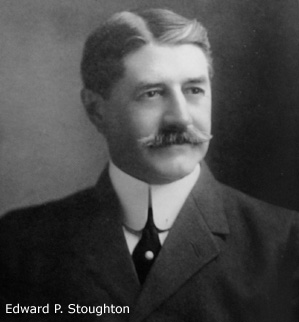Edward Payson Stoughton
 Edward P. Stoughton, the third president of the Millers Falls Company, was born in Gill, Massachusetts, on September 21, 1846. One of the nine children of Timothy and Maria Clarissa Stoughton, his father was a prominent farmer, a state legislator, and the president of a lumber company that operated a water-powered sawmill on the banks of the Connecticut River in Turners Falls. The Stoughtons, interested in a good education for their son, sent young Edward to Williston Seminary, an up-and-coming preparatory school in Easthampton.(1)
Edward P. Stoughton, the third president of the Millers Falls Company, was born in Gill, Massachusetts, on September 21, 1846. One of the nine children of Timothy and Maria Clarissa Stoughton, his father was a prominent farmer, a state legislator, and the president of a lumber company that operated a water-powered sawmill on the banks of the Connecticut River in Turners Falls. The Stoughtons, interested in a good education for their son, sent young Edward to Williston Seminary, an up-and-coming preparatory school in Easthampton.(1)
After graduating from Williston, Edward Stoughton joined the Union Army but was mustered in during the latter part of the Civil War and never called to battle. He was just twenty-one when Henry L. Pratt, a fellow Franklin County native and president of the newly formed Millers Falls Manufacturing Company, hired him to help manage the firm’s New York Office. It was an excellent choice. Stoughton was a gifted salesman and proved especially adept in the international sales arena. In 1870, he booked the company’s first export order from Charles Churchill & Co. Ltd., of Birmingham, England. The firms were still doing business ninety-one years later. Edward Stoughton soon became the point person for the Millers Falls Company’s European marketing effort. He invested heavily in the company and as his shareholdings increased went on to serve as Secretary of the Board of Directors.(2)
Stoughton was proud of his rise through the ranks and spoke freely of his early days with the company. In 1921, the following paragraphs appeared Brace Bits, the Millers Falls Company newsletter.(3)
Mr. E. P. Stoughton was Mr. Pratt’s general handyman about the place, occupying all the positions at once from porter, packer, errand boy, bookkeeper, salesman, correspondent and manager. In other words from “Office Boy to President” has nothing on Mr. Stoughton. He has filled all the chairs.
... Mr. Stoughton developed into a very husky young man, his constant association with Jack screws as dumb bells, and packing cases as club weights combined with the salt air from the East River, which occasionally blew up Beekman Street, put him in a class with Jack Dempsey. The story is told of an argument that Mr. Stoughton had with a truckman who quibbled about taking a keg of nuts weighing 210 lbs. up the stairs, and onto his truck. Mr Stoughton bet the truckman the value of the keg of nuts that he could pick that keg up and carry it up the stairs to the sidewalk, and deposit it on the truck. The bet was made and Mr. Stoughton who weighed 135 lbs. accomplished the task with ease. Mr. Stoughton says rather modestly that he doesn’t believe he would ever think of doing it again, and that he is still looking for the truckman to pay his bet.
Upon the death of an ailing Henry Pratt in 1900, Stoughton became vice-president of the company and assumed responsibility for all aspects of the New York office. Although Levi Gunn, a co-founder of the operation, succeeded Pratt as president, he remained in Millers Falls, Massachusetts, where his experience in production and management were better suited to the oversight of the plant than to the sales end of the business. That Stoughton considered himself de facto president can be inferred from his obituary, which lists his presidency as beginning in 1898—two years prior to the death of Henry Pratt and ignores Gunn’s tenure entirely. When Gunn retired in 1910, Edward Stoughton became company president, a position he held until 1920 when he stepped aside to become Chairman of the Board. Reflecting, perhaps, his background in sales, Stoughton’s presidency was marked by an increase in the size of the operation’s product line rather than the expansion of physical plant that characterized the tenure of his production-minded predecessor.
Stoughton continued in the Chairman’s position until age eighty-five, making daily visits to the office, save for the summer months, when he traveled in Europe. A New Yorker to the core, Edward Stoughton’s affiliation with the company ensured that he had the means to maintain a residence with a prestigious Fifth Avenue address and to maintain his frequent European travels. He died October 3, 1938, aboard the Queen Mary, on a return trip from London, as the luxury ocean liner was approaching the dock. A week earlier, he and his wife had celebrated his ninety-second birthday.(4)
Illustration credit
Hardware Dealers Magazine, January 1915. p. 108.
References
- Stoughton family: Encyclopedia of American Biography. New Series. v. 11. New York: American Historical Society, 1940. p. 597.
- “Did you know —” Dyno-mite June 1961, p. 8.
- C. M. Heath. “The History of Our New York Store.” Brace Bits. v. 1, no. 3, January 1921, p. 1-2.
- Stoughton’s obituary: New York Times, October 4, 1939, p. 25, col. 5.